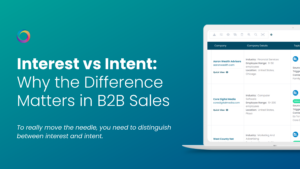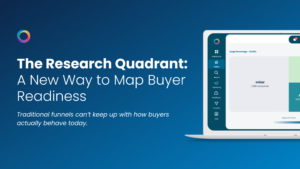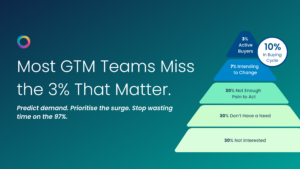The use of buyer intent data is becoming more and more popular as businesses around the world use it to drive their sales and boost marketing initiatives every day. However, there is still a hugeportion of companies out there who are missing out on the latest trend, either due to lack of awareness or fear of trying something new.
Generating a consistent stream of highly qualified leads is one of the fundamentals of good marketing, but with so much competition out there, it can be difficult. But what if you could find qualified data, that gave you more information than ever before? What if you knew exactly who these people were and that they already knew who you were, or at least were shopping within your industry field? Well, with buyer-intent software engines like Zymplify, you can have all this information in front of you and use it to optimise all your sales and marketing efforts in 2019.
What is Buyer Intent Data?
Watch our webinar on Buyer Intent Data now.
Buyer intent data identifies which businesses are actively researching you or the industry field that you work in. This sounds great right? The triggers are like a signal, telling you when these prospects are looking for businesses like yours.
The buyer intent data determines a purchase intent signal from the activity the person is conducting online. In the simplest terms, it’s everything that a prospect does long before they visit your site and submit their details. The ‘hints and clues’ that they leave behind are what we call buyer intent.
Pinpointing Research
According to a report conducted by the Content Marketing Institute and Smartbrief, 81% of senior business leaders reported they do research before bringing in a vendor. If you’re lucky, you will see prospects dropping into your pipeline consistently thanks to your marketing efforts. But often people will research anonymously or not even find your site at all. If you’re struggling to generate leads or get in front of the right buyer persona, then buyer intent data could help you significantly. It cuts out the guesswork and creates the most accurate way to predict who is ready to buy your product or service.
Companies around the world use buyer intent data to improve the performance of their marketing efforts. This could include, but is not limited to:
- Targeted advertising
- Demand generation programs
- Content marketing
What kind of research are they conducting?
Consumers want to know they can trust you, and the majority of them won’t contact a vendor until they have done their own research. With so many competitors, who all offer different features and benefits, your prospective customer has a few options to weigh up. Some factors consumers might research in 2019 include:
- Who provides the best support and customer service?
- Which provider offers the least risk?
- How user-friendly is your product/service?
- How does your price compare with your competitors?
In short, this means that it’s not just about price and features, but the experience too. People want to know how they’ll feel when they use your product or service, and if your claims are valid. A fantastic way to find this out is word-of-mouth marketing, and review sites. The same study found that the most important sources of content influencing the purchase process are not from the vendors themselves. The most influential sources include:
- One-to-one peer recommendations – 80%
- Original research – 74%
- Product reviews – 58%
Another study by Nielsen found the top three sources which people put their trust into, are:
- Recommendations from people I know – 83%
- Branded websites – 70%
- Consumer options posted online – 66%
Your customers are already talking about you, and your prospects are listening. If someone has found a review of your product or service online, or they have actively typed in your name, then you know their intent to buy is high. These are people who are already engaged with your company, know what you have to offer and therefore are already further down the buyer’s funnel. Buyer intent data allows marketers to discover what is essential to customers and solve their problems.
How does buyer intent data work?
Millions of people all around the world search for topics and engage with different forms of content on various sites every single day. They could be on your website, but if you don’t have an efficient tracking code, you could be missing out on lead generation opportunities. Complex buyer intent data algorithms can monitor those engagements to observe contacts taking actions and report the ones that match your ideal buyer profile. For that to work, you need to provide details such as:
- Typical prospect job titles, company size and geography
- Key terms (compound and straightforward terms of product, service, problems and outcomes)
- Influencer and key industry event URLs and/or social handles
- Customer account names and URLs
- Target account names and URLs Competitor names and URLs
This information will get built into an algorithm which then uses machine-based learning and the latest technology to observe and note relevant actions which match your specific criteria. The data will then indicate intent from among the millions of activities that occur every day on the web. These actions include those taken in general search, on competitors’ sites, with industry influencers and major industry events.
Buyer intent will help you align your sales and marketing departments
Having a streamlined marketing and sales process, with collaborative departments, who work together towards the same goal, will help you grow your business significantly. In the past, there might have been tension between the two departments. However, the introduction of buyer intent data has eliminated that friction. The sales team want more sales qualified leads, that are ready to talk to them. The marketing team wants to find them early and nurture them, so they’re ready for sales. When they both work together towards these similar goals, magic happens. Buyer intent data will provide both teams with a universal tool that help them work together seamlessly. There are six common examples of collaborative use cases for buyer intent:
- Discovering additional, active, unknown sales leads
- Reducing churn/boosting loyalty and lifetime value
- Building target account success
- Managing complex buying teams
- Getting involved early enough to establish value
- Trend forecasting and analytics
How do I use buyer intent data to my advantage?
By this stage, you should be aware of the benefits of Buyer Intent Data, and you might be considering trialling some for yourself. But it’s really what you do with it, that will make a difference to your marketing efforts. When used correctly, in-line with a reputable marketing automation software provider, you can find out the names, contact details and positions of the people who are looking at your website. While Buyer Intent Data will give you contact details of prospects who are researching you or your industry, you can enhance it and create bespoke customer journeys to nurture these prospects through the marketing and sales process. It’s these finer details that will allow you to personalise and create highly targeted marketing messages, content, digital ads, emails and social media posts.
How can we help?
Zymplify can help you in 3 easy ways:
- Maximise buyer intent data to identify highly qualified leads that are actively researching your business, or your industry.
- Send these leads on an automated email journey to nurture them to be sales-ready.
- Send these leads to your salespeople, once they have become qualified.
This entire process is automated. So, your sales team only receive leads that are highly qualified, know your business and what you do, and are actively looking to buy. To find out more about buyer intent data and how Zymplify can help, simply click here to sign up for a demo of our product.



